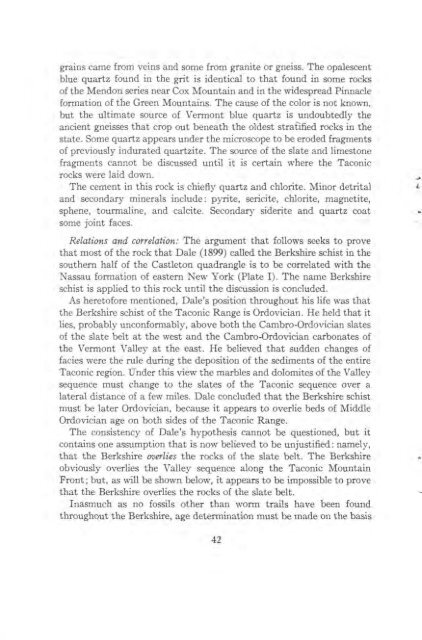STRATIGRAPHY AND STRUCTURE CASTLETON AREA VERMONT
STRATIGRAPHY AND STRUCTURE CASTLETON AREA VERMONT
STRATIGRAPHY AND STRUCTURE CASTLETON AREA VERMONT
You also want an ePaper? Increase the reach of your titles
YUMPU automatically turns print PDFs into web optimized ePapers that Google loves.
grains came from veins and some from granite or gneiss. The opalescent<br />
blue quartz found in the grit is identical to that found in some rocks<br />
of the Mendon series near Cox Mountain and in the widespread Pinnacle<br />
formation of the Green Mountains. The cause of the color is not known,<br />
but the ultimate source of Vermont blue quartz is undoubtedly the<br />
ancient gneisses that crop out beneath the oldest strafified rocks in the<br />
state. Some quartz appears under the microscope to be eroded fragments<br />
of previously indurated quartzite. The source of the slate and limestone<br />
fragments cannot be discussed until it is certain where the Taconic<br />
rocks were laid down.<br />
The cement in this rock is chiefly quartz and chlorite. Minor detrital<br />
and secondary minerals include: pyrite, sericite, chlorite, magnetite,<br />
sphene, tourmaline, and calcite. Secondary siderite and quartz coat<br />
some joint faces.<br />
Relations and correlation: The argument that follows seeks to prove<br />
that most of the rock that Dale (1899) called the Berkshire schist in the<br />
southern half of the Castleton quadrangle is to be correlated with the<br />
Nassau formation of eastern New York (Plate I). The name Berkshire<br />
schist is applied to this rock until the discussion is concluded.<br />
As heretofore mentioned, Dale's position throughout his life was that<br />
the Berkshire schist of the Taconic Range is Ordovician. He held that it<br />
lies, probably unconformably, above both the Cambro-Ordovician slates<br />
of the slate belt at the west and the Cambro-Ordovician carbonates of<br />
the Vermont Valley at the east. He believed that sudden changes of<br />
facies were the rule during the deposition of the sediments of the entire<br />
Taconic region. Under this view the marbles and dolomites of the Valley<br />
sequence must change to the slates of the Taconic sequence over a<br />
lateral distance of a few miles. Dale concluded that the Berkshire schist<br />
must be later Ordovician, because it appears to overlie beds of Middle<br />
Ordovician age on both sides of the Taconic Range.<br />
The consistency of Dale's hypothesis cannot be questioned, but it<br />
contains one assumption that is now believed to be unjustified: namely,<br />
that the Berkshire overlies the rocks of the slate belt. The Berkshire<br />
obviously overlies the Valley sequence along the Taconic Mountain<br />
Front; but, as will be shown below, it appears to be impossible to prove<br />
that the Berkshire overlies the rocks of the slate belt.<br />
Inasmuch as no fossils other than worm trails have been found<br />
throughout the Berkshire, age determination must be made on the basis<br />
42













